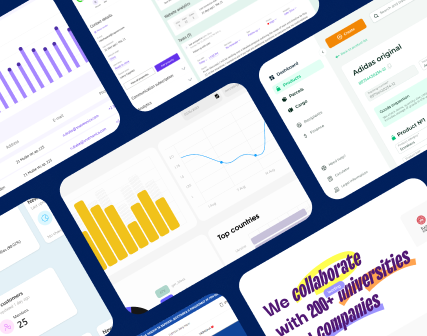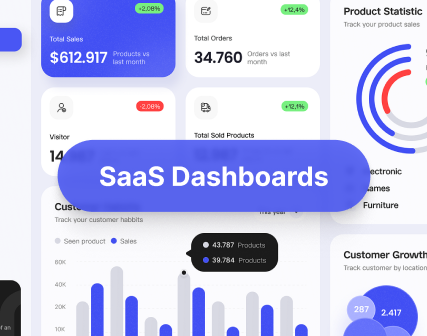UX competitor analysis: surpass your rivals to boost business CR
As the name suggests, UX competitive analysis is the assessment of competitive web products that are on the market and/or impact your product. During this process, specialists detect the strengths and weaknesses of your rivals to provide valuable insights on how you can boost your product and get a competitive advantage.
What should you know to choose a good specialist in UX competitor analysis? Does using ChatGPT for UX competitor analysis allow business owners to conduct such analysis by themselves? Let’s find the answers to these and other pivotal questions below!
How to do competitor analysis UX: key principles and steps
Competitor UX analysis is a well-planned and multi-stage process that requires great attention to the preparatory phases. Before comparing your business with the rivals, you should know the answers to 3 essential questions:
- Who is the target audience for your product?
- What are the requirements and problems of our target audience?
- Who else in the market is already solving our users' problems?
With these questions in mind, you come to the next pivotal step – defining the main goal of your UX competitor analysis. You may be interested in analyzing website elements like navigation, mobile web product version, checkout design, etc.
On the other hand, sometimes business owners can’t understand the reasons for low conversion and don’t know the websites’ weak sides. In this case, a comprehensive and detailed UX competitor analysis of all interface blocks will help you choose the best redesign strategy to boost your business.

At the same time, if you want not to beat but get inspiration from your rivals, apply for benchmarking, which lies in studying your competitors to use their positive experience for your project. It can be used both for startups and operating digital products. In the first case, you will be able to demonstrate a high-quality MVP of the future product to the management or investors. In the second – get important insights and find new ideas for implementation.

What are the main stages of UX competitor analysis?
After you get to know everything about your own business and its target audience, we come to the assessment of your competitors that includes the following phases:
- Searching for relevant competitors and their grouping
To manage this, you can look through:
- Google;
- Customers’ reviews;
- Maps and directories like Google Maps;
- Specialized services.
- Analysis of the competitive products’ features
You have to define so-called points of parity and points of difference for each competitor, where:
- Points of Parity are the essential features found in all competitor products, without which your new product would be incomplete and unable to meet basic user needs.
- Points of Difference are the standout features that distinguish a website from others, serving as the key reason why users choose this product over its competitors.


- Analysis of UI patterns
To do this, collect UI solutions and usage patterns from your competitors. A good way to do this is to take screenshots of the relevant pages and/or parts of the product and add them to your working file.
- Competitor analysis UX features
Depending on the project goal, you can assess the website’s:
- Navigation;
- Menu;
- Entry points;
- Page loading speed;
- Adoptive version;
- etc...
- Summarizing and presenting the results
After conducting UX competitor analysis, the specialist summarizes the results and presents you with the insights of his/her investigation. It's important that the expert highlights the most important facts and keeps you from overloading you with large tables or unimportant screenshots.
UX competitor analysis template
Since UX competitor analysis usually involves processing a large amount of data, it is vital to organize your findings. There is no universal UX competitor analysis template because everything depends on the scope of the investigation and your primary goals.
If you want to analyze the competitor's product as a whole, it’s better to create a table where you can record not only the competitor's features but also separate interface elements, such as filters, the ability to buy in 1 click, menu navigation, etc. These features can be marked in the table with simple marks: yes/no, present/absent, or contain a brief description.
On the other hand, if the purpose of the analysis is to evaluate the interface's usability, you can introduce a scoring system for assessing key website features.
For example:
- Not implemented — 0 points;
- Poor implementation — 1 point;
- Average implementation — 2 points;
- Perfect implementation — 3 points.
Later, you can compare the total numbers to define your key competitor when analyzing several rivals.
Using ChatGPT for UX competitor analysis: do or not to do
AI technologies are developing and improving at a frightening speed. Despite different attitudes toward it, such systems as ChatGPT can make your life as a business owner much easier.
In terms of UX competitor analysis, you can apply AI-driven technologies to process vast amounts of data and get a detailed side-by-side comparison of your competitors. However, in practice, it may be more challenging than it seems.
To get high-quality data, you must “make friends” with ChatGPT by formulating and using clear, explicit prompts tailored to extract specific insights about the companies of interest. It is pivotal to include relevant keywords in your queries, provide enough information about the results you want to get, and be coherent.
However, when using ChatGPT for UX competitive analysis, instead of blindly copying all your competitors' solutions, try to understand “Why did they do it?” After all, what works well for one product may be entirely useless for another. It is also important to double-check the data you find, as it may not be done professionally or may not be accurate due to outdated data.
If you don’t know how to conduct competitor research UX by yourself, applying to a professional UX/UI agency would be better to get deep and valuable business insights.
Final considerations as to the competitor research UX
The main reason to opt for UX competitor analysis is the depth of business insights it gives you. Thanks to competitor research UX, you will be able to figure out:
- What your competitors are offering;
- What kind of monetization do they have;
- What are the strengths and weaknesses of their product to compare them to our capabilities;
- How the competitors solve their customers needs.
Based on this data, you can analyze your advantages and disadvantages and predict whether applied methods will work for you. In other words, it will help you find website growth points and increase your business profits.
FAQ
Question reference
Answer reference
More real-world Turum-burum cases?
Review our vast portfolio of cases in a variety of business fields to make sure of our expertise.
Go to Portfolio




.png)
.png)













